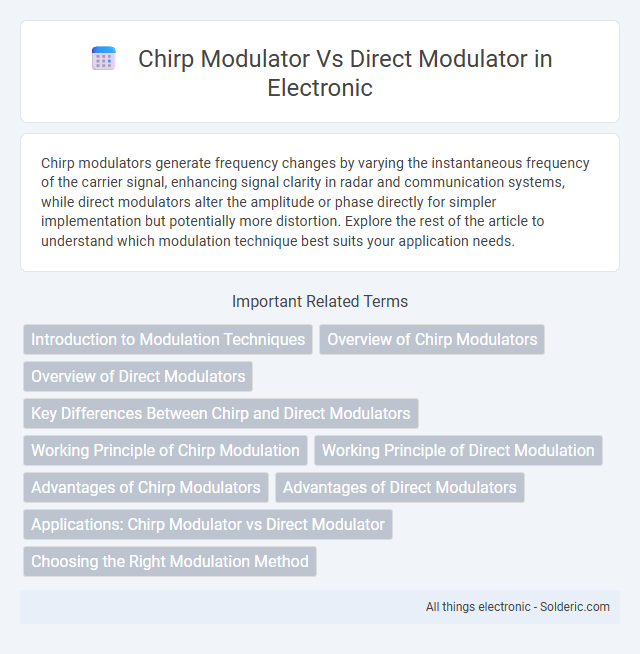Chirp modulators generate frequency changes by varying the instantaneous frequency of the carrier signal, enhancing signal clarity in radar and communication systems, while direct modulators alter the amplitude or phase directly for simpler implementation but potentially more distortion. Explore the rest of the article to understand which modulation technique best suits your application needs.
Comparison Table
| Feature | Chirp Modulator | Direct Modulator |
|---|---|---|
| Modulation Type | Frequency modulation with intentional frequency sweep (chirp) | Amplitude or frequency modulation directly at the source |
| Frequency Stability | Controlled frequency variation over time | Stable frequency with minimal unintended variation |
| Applications | Radar, LIDAR, spread spectrum communications | Basic optical communication, direct laser modulation |
| Complexity | Higher due to frequency sweep generation | Lower, simpler implementation |
| Signal Bandwidth | Wider bandwidth due to chirp effect | Narrower bandwidth |
| Advantages | Improved range resolution, reduced interference | Reduced cost, simplicity, direct control over output |
| Disadvantages | More complex design, potential signal distortion if uncontrolled | Limited performance for precision applications |
Introduction to Modulation Techniques
Chirp modulation varies frequency over time to improve signal robustness against interference and multipath fading, commonly used in radar and communication systems. Direct modulation alters the laser's drive current to encode data directly onto the optical carrier, enabling simpler and cost-effective transmitter designs. Understanding these fundamental modulation techniques highlights trade-offs in complexity, signal quality, and spectral efficiency pertinent to optical and RF communication technologies.
Overview of Chirp Modulators
Chirp modulators generate frequency variations within optical signals to reduce signal distortion and enhance transmission quality in fiber optic communication systems. These modulators utilize controlled frequency chirping to improve tolerance to chromatic dispersion compared to direct modulators, which modulate light intensity without frequency shifts. Chirp modulation techniques are essential for long-distance and high-speed data transmission, offering better performance in wavelength division multiplexing (WDM) networks.
Overview of Direct Modulators
Direct modulators change the optical signal's phase or frequency by altering the laser's injection current, resulting in inherent chirp that affects signal quality in fiber-optic communication. Chirp introduces frequency variations during modulation, which can cause dispersion and limit transmission distance, making direct modulators less ideal for long-haul systems. Understanding the chirp characteristics of your direct modulator is essential for optimizing performance and minimizing signal distortion.
Key Differences Between Chirp and Direct Modulators
Chirp modulators introduce controlled frequency variations within an optical signal, enhancing linewidth and reducing signal distortion, whereas direct modulators vary the light intensity directly without altering frequency. Chirp modulators are preferred in long-haul optical communication for their ability to minimize chromatic dispersion effects, while direct modulators are simpler, cost-effective solutions suited for short-reach systems. Key differences include chirp control effectiveness, impact on signal integrity, and application suitability based on transmission distance and system complexity.
Working Principle of Chirp Modulation
Chirp modulation operates by varying the instantaneous frequency of a signal over time, typically sweeping linearly across a bandwidth to encode information, which enhances resistance to noise and multipath distortion. Unlike direct modulation, which directly alters the amplitude or phase of the carrier wave, chirp modulation exploits frequency variation to improve signal robustness and range. Your communication system benefits from chirp modulation's ability to maintain signal integrity in dynamic or noisy environments.
Working Principle of Direct Modulation
Direct modulation works by varying the laser diode's injection current to directly change the output light frequency and amplitude, resulting in simultaneous intensity and frequency modulation (chirp). This technique eliminates the need for external modulators, reducing system complexity and cost, but can introduce signal distortion due to chirp-induced frequency variations. Direct modulation is commonly used in short-reach optical communication systems where cost-efficiency and simplicity are prioritized over high spectral purity.
Advantages of Chirp Modulators
Chirp modulators offer superior performance in minimizing signal distortion and optimizing bandwidth efficiency compared to direct modulators. Their ability to generate frequency-swept signals enhances range resolution and reduces interference in radar and communication systems. You benefit from improved signal clarity and extended operational capabilities when using chirp modulation technology.
Advantages of Direct Modulators
Direct modulators offer superior modulation efficiency by directly altering the laser's injection current, resulting in faster response times and simpler device architecture. This approach reduces system complexity and manufacturing costs, as external modulators and additional optical components are unnecessary. Your optical communication system benefits from lower power consumption and enhanced modulation bandwidth, making direct modulators ideal for high-speed data transmission.
Applications: Chirp Modulator vs Direct Modulator
Chirp modulators are widely used in radar systems, optical communication, and ultrawideband applications due to their ability to spread the signal spectrum and improve range resolution. Direct modulators, commonly found in fiber optic transmitters and simple RF communication devices, offer straightforward implementation and low cost for intensity modulation tasks. Your choice between chirp and direct modulation depends on the specific needs for bandwidth, signal integrity, and system complexity.
Choosing the Right Modulation Method
Choosing the right modulation method depends on the application's specific requirements for signal integrity and bandwidth efficiency. Chirp modulators offer superior resistance to signal distortion and multipath interference, making them ideal for radar and communication systems demanding high resolution and reliability. In contrast, direct modulators provide simpler implementation and lower cost, suitable for applications with less stringent performance needs and where system complexity must be minimized.
Chirp modulator vs direct modulator Infographic

 solderic.com
solderic.com